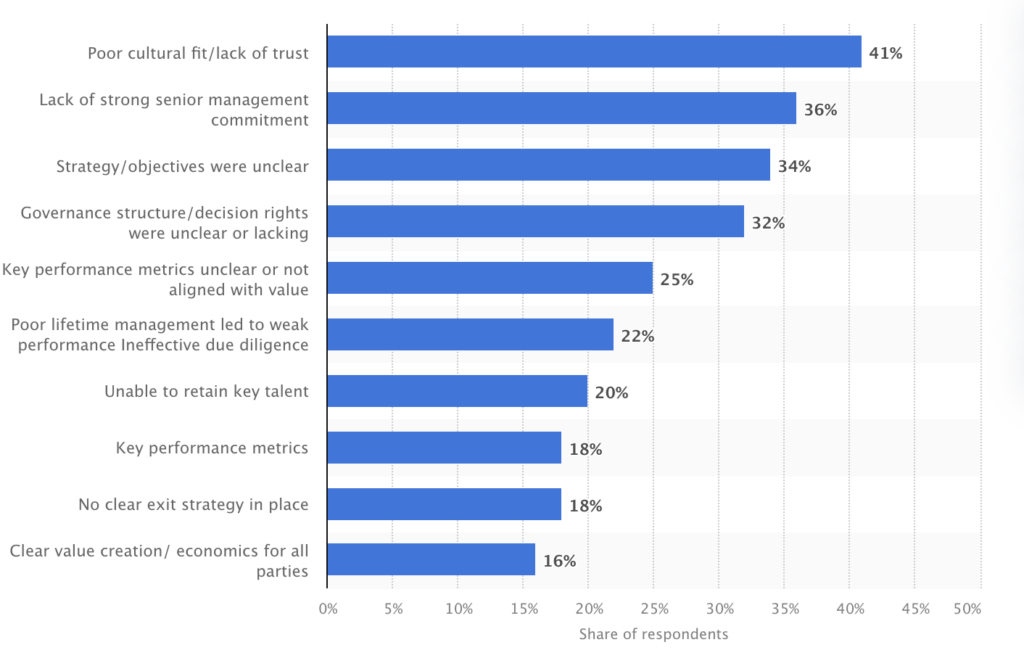M&A is a complex, multi-stage process that involves many players both from the sell- and buy-side and requires a thorough planning.
According to Deloitte’s 2022 M&A Trends Survey, 47% of executives and 46% of private equity investors name an M&A strategy as a key element in achieving the deal’s success. And a well-thought-out M&A strategy is impossible without quality initial market research, skilled professionals involved, and, most importantly, proper project management.
This article dwells on the basics of M&A project management and ways it can streamline the M&A process.
What is the M&A management process?
M&A project management is a process of implementing the best practices of classic project management during mergers and acquisitions.
When one company purchases another or two companies consolidate, M&A project management handles all the organizational issues in each phase of the pre- and post-merger activities.
Practically, M&A deal management means breaking each M&A activity into the main project management phases.
Note: According to PMI, there are 5 basic project management phases: initiation, planning, execution, monitoring, and closure.
In other words, M&A management defines the key roles and establishes the timelines, benchmarks, and targets of the main M&A activities.
Project management techniques can also be used in other M&A activities such as investment management M&A, asset management M&A, and M&A wealth management.
The critical role of effective M&A management
Given the multifaceted nature of M&As, the fact that they consist of many stages, and that many parties are usually involved in a single transaction, a deal’s success largely depends on how all the processes are organized.
According to Statista’s 2021 survey conducted among M&A practitioners, 34% of respondents indicate unclear strategy and objectives as the main factor for M&A failure. At the same time, 25% blame unclear key performance metrics, and 22% say it was poor lifetime management that led to the deal’s failure.

All these issues could be solved if the companies involved applied decent M&A project management, which provides guidelines and helps structure the deal.
Let’s see how mergers and acquisitions management actually contributes to the improvement of the M&A process:
- Better coordination
With the project management tools, all the M&A activities such as due diligence, negotiation, or integration and parties involved are better coordinated and thus more effective. M&A project managers ensure that all the objectives and tasks are timely completed.
- Realistic pricing
M&A deal management ensures that the transaction creates value for the acquiring company and the target company since it helps to identify synergies and cost savings.
- Improved communication
M&A management teams work on establishing a clear and effective cross-functional collaboration between shareholders, customers, responsible employees, auditors, executives, and all other parties involved in the transaction.
- Specified roles and responsibilities
M&A deal management helps to clearly define who is responsible for what and at what stage of the M&A process, which helps everyone to stay effective and work on the deal’s success.
- Tasks prioritization
Since merger and acquisition deals involve lots of tasks and processes, project management helps to correctly identify tasks’ priority and thus, ensure their timely and effective completion.
- Risk management
Project management helps to avoid possible post-merger integration risks by timely identifying and addressing pain points during the M&A process.
What does an M&A project manager do?
An M&A project manager is a specialist responsible for managing the transaction who leads and coordinates all the activities of the deal throughout its main stages: sourcing, due diligence, deal negotiation, and post-merger integration.
An M&A project manager is responsible for:
- Managing budgets and timelines to ensure the project stays within budget
- Managing relationships between all the parties involved in the transaction: shareholders, executives, advisors, auditors, attorneys, responsible employees, etc.
- Planning and objectives setting
- Defining key roles and responsibilities
- Prioritizing tasks and ensuring their timely completion
- Integration planning
- Overseeing and coordinating post-merger tasks
M&A project manager skill set
A good M&A project manager should have expertise in the following areas:
- Governance
Deal project managers should know how to structure and lead teams and control processes and task execution to ensure a successful and effective deal process.
- Finances
M&A project managers should have good financial knowledge to be able to perform financial planning and budget management.
- Risk management
Project managers should be familiar with state, federal, and local laws, risk analysis, and legal considerations of the deal, such as regulatory compliance requirements. This is to be able to spot the potential risks and avoid financial losses.
- Performance management
An M&A project manager develops metrics to reach the post-merger integration objectives and oversees their execution.
- Work management
A project manager should know how to manage a team, establish a collaborative work environment, and create a productive workflow that will help to achieve the deal’s goals. It implies developing an efficient project management strategy and using certain project management tools and techniques.
- Information management
An M&A project manager knows how to manage large amounts of data, and especially how to handle highly confidential information shared during the due diligence process.
- Quality assurance
An M&A project manager should know how to ensure all the parties involved in the deal adhere to the best practices to complete the deal successfully. Also, they should ensure that processes and approaches are documented so that they can be used to improve future transactions.
- Resourcing
An M&A project manager should know how much time, human capital, money, and other resources are needed to complete a particular M&A project/task at each stage of the M&A process. A project manager should allocate and manage these resources effectively across all the stages of the transaction.
Key components of successful M&A management
M&A project management during the transaction could be divided into two phases: pre-merger project management and post-merger project management.
Pre-merger project management implies planning and organizing all the M&A activities before the closure. Post-merger project management involves organizing the integration process and executing post-merger tasks.
Before describing the fundamentals of pre-merger and post-merger project management, let’s define the main steps a project manager should take during mergers and acquisitions:
- To start a project, an M&A project manager works on creating a project charter. This document defines the project objectives, scope, and responsibilities and is to be approved by the key project stakeholders.
- The next step is to break the M&A project into tasks and subtasks, set due dates, allocate resources and human capital, estimate costs, and assess potential risks.
- After this, it’s time for project execution. An M&A project manager should organize the team, assign roles and responsibilities for each team member, and then coordinate the team’s efforts. The project manager also plans kick-off and status meetings, communicates with stakeholders, and tracks performance.
- Before the project closure, an M&A project manager records the processes and lessons learned.
- After the project closure, an integration process starts and dedicated project managers ensure it’s smooth and all the objectives are met.
Now, let’s take a closer look at the fundamentals of pre- and post-merger project management.
8 pre-merger project management components
During the pre-merger phase of a transaction, project management is used to perform M&A tasks at each stage. Project managers define key roles and responsibilities for each stage, assign tasks, allocate resources, estimate time and costs, evaluate risks, and track progress.
The pre-merger tasks where M&A project management is used are the following:
- Defining strategy. It’s about determining the expectations from the deal, ensuring that the reasoning is realistic, and confirming that it aligns with the acquiring or to-be-acquired company.
- Screening. This phase involves establishing the criteria for potential targets (selling or acquiring companies), searching for candidates that match these criteria, and evaluating the most fitting targets.
- Preparatory work. This phase is about getting ready for the deal initiation. If a target company is receptive to a deal, then potential acquiring firms sign a confidentiality agreement and review the target. In case the review results are favorable, a written offer is submitted.
- Negotiations. This stage of the transaction is about both the acquirer and the seller negotiating the deal terms. When the consensus is reached and the price is agreed, both sides sign a letter of intent.
- Due diligence. This phase is about performing a thorough investigation of the target’s background, financials, and other important documents. Due diligence is always about many tasks and people involved, that’s why proper project management is essential.
- Contract drafting. In case of satisfactory due diligence results, both sides sign a final contract for the transaction.
- Financing. This is a stage of financial management, when the acquiring company searches for ways of financing the transaction.
- Closure. The representative of the acquirer and the merged company sign the final contracts and close the deal.
6 post-merger project management components
The post-merger phase of a transaction starts after its closure. It focuses on the key activities of integration planning and implementation.
Usually, a dedicated project management office (PMO) is hired to be in charge of all the post-merger activities. The PMO defines procedures, sets standards, defines key roles, assigns tasks, establishes workflow, communicates with stakeholders, monitors performance, and ensures that the project meets deadlines and stays on budget. Often, a PMO is also responsible for change management M&A.
Among the post-merger tasks where M&A project management is used are the following:
- Team planning. A project manager allocates required resources and assigns key roles and responsibilities.
- Integration process. An M&A project manager plans the integration process by breaking it down into tasks and subtasks and assigning responsible people for their implementation.
- Creation of organizational structure. This phase of post-merger project management is about defining who is responsible for what, who reports to whom, and at what matter.
- Stakeholder updates. A project manager keeps in touch with stakeholders and informs them about all the project’s updates on time.
- Controlling performance. A project management team monitors the team’s performance, detects pain points, and timely addresses them.
- Achieving M&A goals. A project manager ensures all the post-merger integration objectives are met and that the project follows deadlines.
Best practices for streamlining M&A project management
Now, let’s take a look at the best practices to improve M&A project management during the pre- and post-merger phases.
Pre-merger project management tips
- Consider outside expertise
In case you don’t have a lot of M&A expertise, it’s recommended to hire outside M&A experts who are closely related to the mergers and acquisitions field. This will ensure that all the aspects of the M&A process are properly addressed.
- Be especially careful with due diligence
Poor management of the due diligence process might lead to missing out on essential information and thus, impose reputational and financial risks on the deal.
- Develop a project-specific workflow
Create a well-thought-out project workflow with clearly defined roles and responsibilities, that address the needs of a particular M&A phase.
- Engage the C-level executives
Ensure that senior management and board members are aware of the project’s progress and understand the M&A strategy.
- Prioritize tasks and actions
Identify tasks that could bring an immediate payoff to the business and prioritize them to demonstrate ROI on the deal.
- Ensure clear communication through the team
At each stage of the M&A project management, ensure that every team member knows what’s going on, what to do, and what to avoid doing till the deal’s finalization.
- Opt for M&A software tools
Dedicated software solutions, such as virtual data rooms, can immensely streamline the M&A process and, thus, accelerate decision-making. For example, VDRs are often used during the due diligence process since they allow for secure data storage and effective collaboration of all the parties involved.
Using a phase-gate process model
One of the practical project management tools often used during the pre-merger M&A phase is the phase-gate (or stage-gate) process model.
A phase-gate model implies an obligatory review of each project stage before moving to the next one. It presupposes setting clear criteria that should be met at each stage of the M&A process. Without meeting that criteria, a team can’t proceed with the next project stage.
In the pre-merger M&A project management, there are 3 main decision-making points, when the phase-gate model is used:
- Strategy approval
At this stage, you decide on whether a candidate can become a potential target based on the set criteria.
- Negotiation approval
At this stage, you decide on whether to proceed with the negotiation with a particular candidate based on the review of the target’s background and financials.
- Deal approval
At this stage, you decide on whether to proceed with the deal and seek approval from the senior management and the board.
Note: M&A practitioners also often opt for the M&A pipeline management model, which helps to break down the whole process into separate stages. Just like with M&A management, creating an M&A pipeline model breaks the M&A process down into logical stages, which helps to ensure all the M&A tasks are fulfilled.
Post-merger project management tips
- Thoroughly plan a post-merger integration project
You should plan every stage of the post-merger integration process: think of the milestones, key people to involve, tasks and responsibilities, deadlines, and lines of communication.
- Ensure clear and regular communication
The communication through the post-merger integration phase should be impeccable. For this, maintain a single source of communication where all the issues will be discussed and tracked and ensure each team member gets timely updates on the progress.
- Allocate resources wisely
You should carefully work on the staff, time, and money estimates since the post-merger integration is a long and complex process. Additionally, think of involving third-party experts such as technical specialists.
- Take care of people
To avoid culture clashes, assign a full-time project leader who will be responsible for a smooth transition of human resources from all core businesses into a single merged company. Clearly describe transition stages and assign key roles and responsibilities.
- Plan Day One
Day One should celebrate the culmination of the deal process and the first day of the new organization. Set the milestones that should be achieved till Day One and plan the activities that should take place during the first day.
- Plan the first 100 days
Set the post-integration objectives that should be achieved in the first 100 days of the new organization’s operations.
- Regularly monitor the progress
Build a single data dashboard that will have all the stages, milestones, tasks, deadlines, and responsible people indicated.
Final words
M&A project management is an implementation of the best project management practices during the M&A process.
With proper project management, acquisitions and mergers are better organized and streamlined. It helps to achieve better coordination, productive communication, risk management, and realistic pricing. It also prioritizes tasks and clearly defines the roles and responsibilities of everyone involved in the transaction.
M&A project management is usually divided into two phases: pre-merger project management and post-merger project management. At each phase, a project manager applies project management techniques to streamline each M&A stage and achieve better and faster results.


